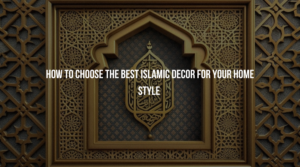In Islamic decor, color is more than just an aesthetic choice; it holds profound significance and symbolism that contributes to creating a serene and harmonious home environment. From the elegant hues of the Kaaba Kiswa to the vibrant shades found in Islamic Art, understanding the role of color can help you design a home that resonates with peace, spirituality, and cultural heritage.
The Symbolism of Color in Islamic Decor
1. Black: The Color of the Kaaba Kiswa
The Kaaba Kiswa, or the black fabric covering the Kaaba in Mecca, is one of the most well-known emblems of Islam. This black cover, also known as the Kaaba Cover, is intricately embroidered with gold and silver threads, showcasing Quranic verses. In Islamic decor, black can symbolize dignity, reverence, and the sacredness of space. Incorporating black elements, such as black Islamic wall art or textiles, can evoke a sense of solemnity and focus in your home.
2. White: Purity and Peace
White is a color that represents purity, peace, and the divine. It is often used in Islamic architecture and interior design to create a sense of openness and tranquility. White walls, furniture, and accessories can reflect light, making spaces feel larger and more inviting. In Muslim home decor, white is often paired with intricate patterns and designs to add depth and interest without overwhelming the senses.
3. Green: Life and Paradise
Green is a particularly significant color in Islam, symbolizing life, nature, and paradise. The Prophet Muhammad is said to have worn a green cloak, and green is often associated with the lush gardens of paradise described in the Quran. Adding green into your home, whether through plants, fabrics, or Islamic wall art, can bring a sense of vitality and renewal to your living space.
4. Blue: Serenity and Spirituality
Another prominent hue in Islamic home decor is blue, which stands for spirituality, the sky, and the heavens. Islamic art frequently uses this color, especially in the mosaics and tiles that cover mosques and palaces. Using shades of blue in your home can create a calm and serene atmosphere, perfect for reflection and prayer. Consider adding blue accents through cushions, rugs, or artwork to enhance the spiritual ambiance of your home.
5. Gold and Silver: Wealth and Divine Light
Islamic interior design frequently uses gold and silver as symbols of affluence, richness, and heavenly light. These colors are prominently featured in the embroidery of the Kaaba Kiswa. Gold and silver accents can add sophistication and richness to your home. Whether through metallic frames, decorative objects, or textiles, these colors can illuminate your space and create a sense of opulence.
Incorporating Islamic Art and Wall Art
Islamic art is renowned for its intricate patterns, calligraphy, and geometric designs. These elements are not only visually stunning but also imbued with spiritual meaning. Incorporating Islamic wall art into your home can serve as a constant reminder of faith and cultural heritage. Look for pieces that feature Quranic verses, traditional motifs, or contemporary interpretations of classic designs.
Incorporating the Kiswah
The Kiswah, the cloth that covers the Kaaba, is a powerful symbol in Islam. Its design and the meticulous craftsmanship involved in its creation can inspire elements of your home decor. You can incorporate patterns and colors reminiscent of the Kiswah in your textiles, wall hangings, and other decorative elements to bring a piece of this sacred tradition into your living space.
Creating a Harmonious Space
When designing your home with Islamic decor, it’s essential to strike a balance between aesthetics and functionality. Here are some pointers to assist you in designing a peaceful area:
1. Choose a color palette
Start with a base of neutral colors like white or beige, and then layer in accent colors like green, blue, or gold. This method guarantees a harmonious and peaceful atmosphere in your room.
2. Incorporate natural elements
Bring in natural materials like wood, stone, and plants to add warmth and texture to your home. These elements can complement the colors and designs of your Islamic decor.
3. Use textiles and patterns
Introduce textiles with intricate patterns, such as rugs, cushions, and curtains, to add depth and interest to your space. Seek for patterns that evoke the artistry and workmanship of traditional Islamic art.
4. Focus on lighting
A calm environment is greatly influenced by the lighting. Enhance the hues and textures of your design by combining natural light, soft ambient lighting, and decorative lights.
5. Personalize your space
You may create a special and meaningful atmosphere in your house by adding personal touches like family photos, heirlooms, and treasured artifacts.
Conclusion
The role of color in Islamic decor is deeply intertwined with cultural and spiritual significance. By thoughtfully incorporating colors like black, white, green, blue, gold, and silver, you can create a harmonious and inviting home that reflects your faith and heritage. Whether through the elegant simplicity of the Kaaba Kiswa or the intricate beauty of Islamic wall art, let color guide you in designing a space that inspires peace, tranquility, and devotion. The careful selection of colors and patterns can transform your home into a sanctuary of spirituality and comfort, reflecting the profound beauty of Islamic traditions.




